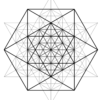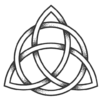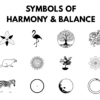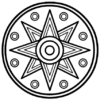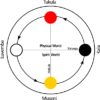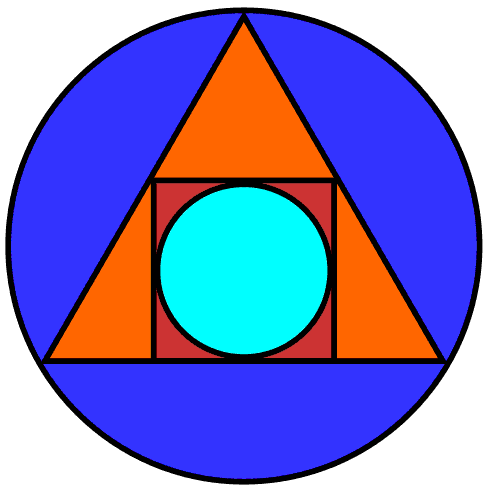
The Circle, Square, Triangle symbol also known as the Philosopher’s Stone is one of the most powerful symbols you can use in your spiritual practice. It’s known in popular culture as a mythical elixir of life and immortality, and it has multiple, very significant meanings in spirituality.
For centuries, spiritual alchemists have used the philosopher’s stone symbol to guide them in transmuting their inner selves, with the aim of attaining inner harmony, wholeness, and spiritual enlightenment.
Self-transformation and enlightenment are among the highest spiritual goals you can aim for. So it’s truly worth studying the philosopher’s stone symbol in depth.
Meaning of the Philosopher’s Stone Symbol in a Nutshell
The philosopher’s stone is a mythical elixir sought after in alchemy, an ancient practice of transforming metals into powerful medicinal substances. The elusive philosopher’s stone is said to turn base metals into gold and to grant its bearer immortality, which is why humans have sought to alchemize it for centuries.
In symbolic form, the philosopher’s stone that is composed of a circle, square and a triangle, has profound spiritual meaning. The symbol represents not only the immortality associated with the mythical stone, but also the totality and divine potential of human consciousness.
The symbol’s large and small circles depict the universal god and the god within you, respectively. This serves as a reminder to find the divine within yourself, align with your divine purpose in the universe, and become the highest form of yourself that you can be.
What’s more, the philosopher’s stone symbol urges you to become conscious of and to unify your spiritual & physical nature. The smaller circle depicts the spiritual realm (mind and soul), the square depicts the material realm (the body), and the triangle represents the union of the spiritual and material: the union of body, mind, and soul.
By developing in these ways into your highest spiritual self, as encouraged by the philosopher’s stone symbol, you’ll ultimately reach spiritual enlightenment.
What do the Shapes, Circle, Square, and Triangle within the Philosopher’s stone represent?
Before we delve into the deeper symbolism of the Philosopher’s stone symbol, let’s first see what the different shapes present within the Philosopher’s stone represents. The symbol is composed of two circles (one inner and one outer), a square, and a triangle. Here’s what these shapes mean.
Inner and Outer Circles
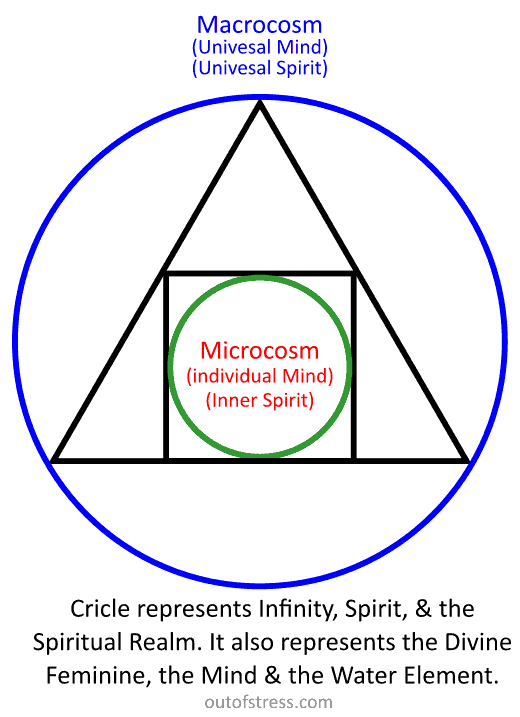
A circle represents God, consciousness, or spirit (spiritual world) due to its infinite, fluid, and unbroken nature.
Just like the spirit, a circle has no beginning or end, signifying eternity. It also has no sides and regardless of the direction you rotate it, the circle maintains its shape, signifying its directionless or all-encompassing nature. The center of the circle, equidistant from any point on its circumference, suggests the omnipresence of the divine, present in all existence.
In addition, the circle also represents the continuous cyclic nature of the universe.
The outer circle in the Philosopher’s stone represents Universal God or the Macrocosm, whereas the inner circle represents the god within you or the microcosm.
Square
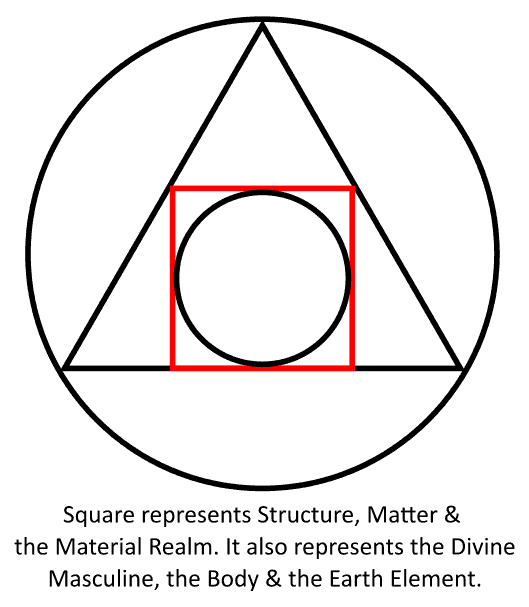
A square represents the material world because of its rigid and structural nature. The four sides of the square (that are equal in length) represent the four elements — earth, air, fire, and water — that constitute the material world.
The four sides also represent the four directions and the four seasons which are important aspects of the material realm. Unlike the fluid nature of circles, squares contain clear lines and angles, representing the solidity and permanence of physical objects.
At the core of the Philosopher’s Stone is the squared circle (square and the circle combined) which represents the universe itself formed by the interaction between spirit and matter.
Equilateral Triangle
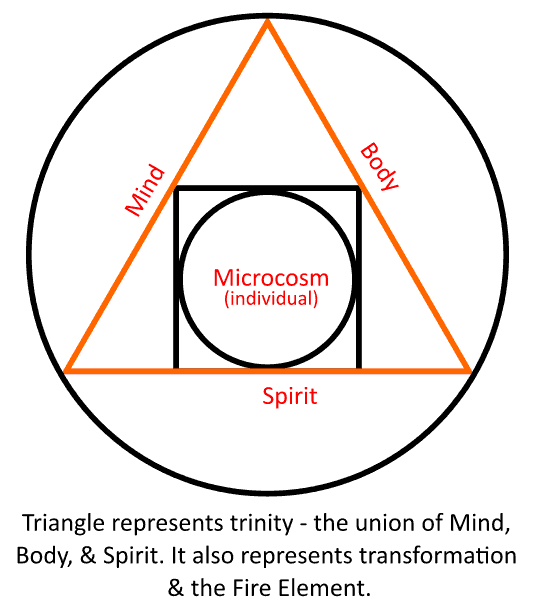
The equilateral triangle represents the underlying energetic connection that exists between the material and spiritual realms (or the Square and the Circle).
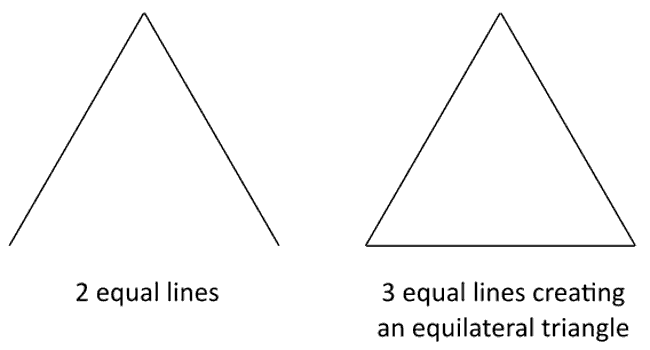
The triangle also represents balance, stability, completion, and the world of form. This is because, you cannot create an enclosed form using two lines. An enclosed form (or shape) can only be created by using three lines as in case of the triangle (as shown in the image above). This is also the reason why a triangle is used to represent the four primary elements – Fire, Water, Earth, and Air that constitute the material world.
Also, the three equal sides of the triangle represent the cyclic nature of existence which includes the triad of creation (where elements manifest in the material world), sustenance (where elements live within the materials world), and destruction (where elements return to the spiritual or formless world).
The sides also represent the triad of Mind, Body, and Spirit that are the main components of human existence.
Also, when pointing upward the triangle represents the Divine Masculine energy and the elements of Fire and Air, whereas when pointing downward, the triangle represents the Divine Feminine energy and the elements of Water and Earth.
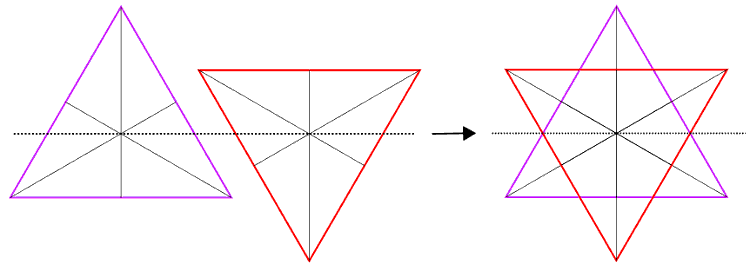
Similarly, when we merge an upward pointing triangle and a downward pointing triangle (so their centers align), we get the six-pointed star, as shown in the image above. The center of the six-pointed star represents the spirit element.
7 Meanings Associated with the Philosopher’s Stone (Circle, Square, Triangle) Symbol
1. Creation and Life’s Divine Essences
Creation occurs through the merging of two primary opposing forces — the divine feminine, representing the spiritual realm, and the divine masculine, representing the material realm.
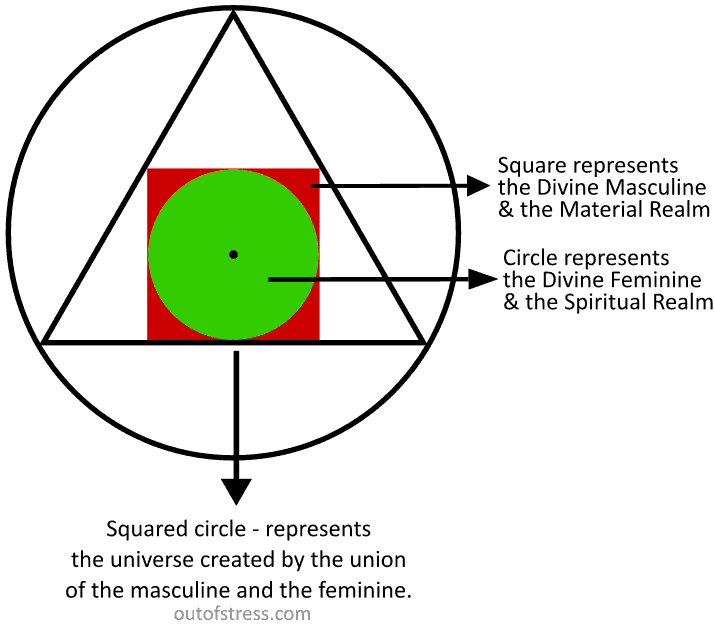
The Squared Circle (as depicted in the image above) in the Philosopher’s Stone perfectly illustrates this concept. The circle represents the divine feminine and the square represents the divine masculine. Both shapes share the same center, symbolizing a singular source dividing into two to bring forth the universe.
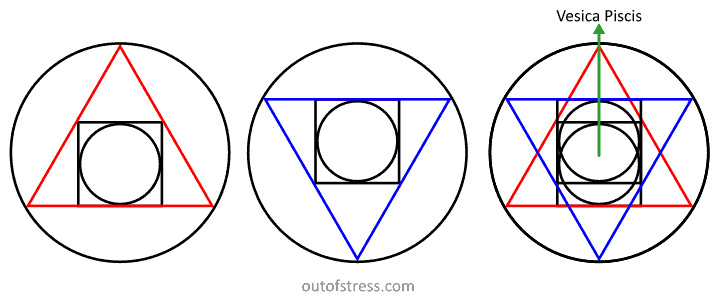
Also, as shown in the image above, if we were to invert the philosopher’s stone symbol and then merge the upright and inverted symbols, we get a symbol that has both the Six-Pointed star as well as the Vesica Piscis. Both these are powerful symbols of creation.
2. The Universe and Its Various Planes
The various shapes in the philosopher’s stone symbol reflect the different planes of the universe. The small circle represents the spiritual plane, the square represents the material plane, and the triangle conveys the divine union of both. This union is a goal to strive for in your life as a spiritual being with physical form.
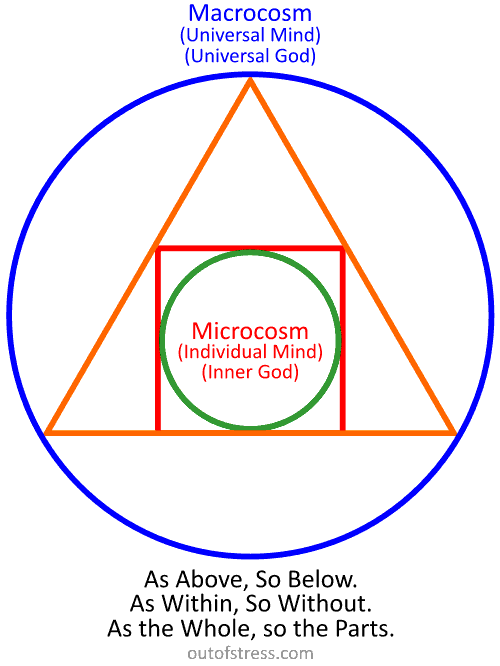
Deepening this meaning, the philosopher’s stone symbol also encapsulates the universe within you and the universe around you. The symbol’s small, inner circle depicts you and your inner world, while the large, outer circle depicts the wider, outer universe that you inhabit.
Since it embodies and unifies multiple facets of the universe, the philosopher’s stone symbol emphasizes a key principle in ancient philosophy: ‘as above, so below’. According to this principle, what happens on one plane of existence (‘above’) is always mirrored on another plane (‘below’).
Thus, as conveyed in the philosopher’s stone symbol: what happens ‘above’ in the outer universe (large circle) will be mirrored ‘below’ in your inner universe (small circle), and vice versa. Similarly, events on the material plane (square) will be reflected on the universe’s spiritual plane (circle), and vice versa.
The philosopher’s stone is therefore a very empowering symbol. It reminds you that you can directly influence the universe around you on various planes, since they are all interconnected.
3. Eternity and the Cyclical Nature of Life
Everything in this universe is cyclic in nature, and these cycles are what sustain the universe.
The Philosopher’s Stone contains two circles – one large and one small, which reflect these universe’s cyclical processes and how they continually recur on larger (macro) and smaller (micro) levels. For instance: while a continuously rotating earth brings cycles of day and night, on a smaller scale your body runs on a regular cycle known as your circadian rhythm. Some important cycles of the universe are as follows:
- Day and night cycle: The cycle of day and night created by the rotation of earth around its own axis.
- Seasonal cycles: The earth’s rotation around the sun creating cycles of spring, summer, fall, and winter.
- Tidal cycles: The gravitational pull of the Moon and the Sun causes ocean tides to rise and fall in a cyclic pattern.
- Water cycle: water cycle includes processes like evaporation, condensation, precipitation, and rainfall maintaining a continuous cycle of water on earth.
- Life cycle: The cycle of birth, sustenance, death, and rebirth that happens on a micro level.
Cell cycle: Cells also go through similar processes of birth, sustenance and death at a micro level.
In terms of your spiritual life, the idea of being governed by recurring cycles may be disheartening if you’ve been trapped in negativity. It may feel as if there is no escape. However, this isn’t the case. It is very possible for you to redirect and realign your inner cycles—and quite luckily, as you’ll read next, the philosopher’s stone symbol can inspire you in this.
4. The Four Elements
The shapes within the Philosopher’s Stone also represent the four elements as depicted in the image below.
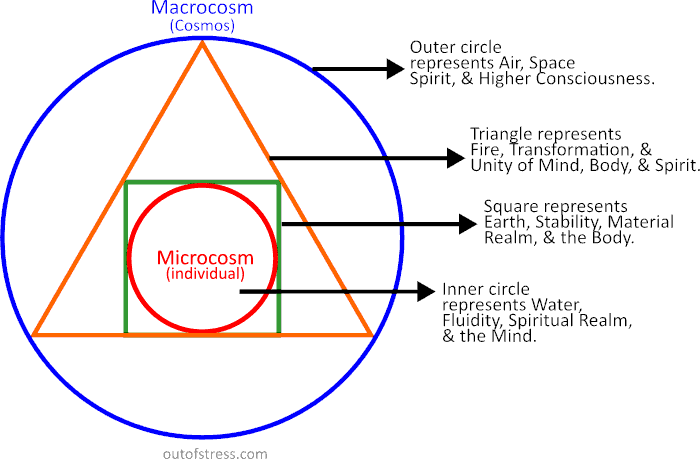
- 1. The inner circle represents the element of water and the Individual Mind.
- 2. The square represents the element of Earth and the Human Body.
- 3. The triangle represents the element of Fire and the union of Mind, Body, and Spirit.
- 4. The outer circle represents the element of Air as well as Ether. It also represents Higher Consciousness, or the Universal Mind.
Bringing a balance between these elements within you is the gateway to enlightened and higher consciousness.
5. Inner Transformation and Shadow Work
In metal alchemy, the philosopher’s stone is thought to transform base metals into gold. As a spiritual symbol, the philosopher’s stone represents transforming your ‘base’ (i.e. your lower) instincts, transmuting them to become your highest possible self. This process of inner transformation is also known as spiritual alchemy, and it was historically often carried out alongside metal alchemy.
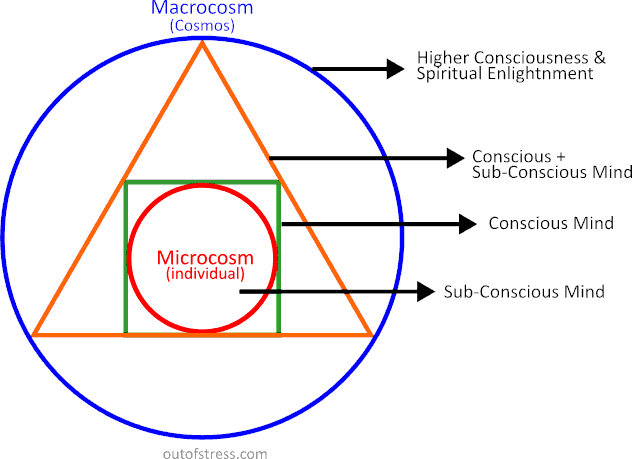
The shapes in the philosopher’s stone symbol represent the different stages of your inner transformation. The innermost circle represents your unconscious, including your unconscious instincts and desires. The square represents you becoming aware of your unconscious. The triangle represents you integrating your unconscious and elevating yourself, while the outer circle represents the new, higher you.
This transformational meaning of the philosopher’s stone symbol makes it very inspirational in shadow work, a practice popularized by the psychologist Carl Jung. In shadow work, you work on discovering your unconscious self, channeling negative traits into positives, and becoming the best, highest version of you. Through shadow work, you become divinely integrated, well-rounded, and whole—as encapsulated by the large, round circle in the philosopher’s stone symbol.
6. Inner Balance and Inner Harmony
The previous subsection unveiled the philosopher’s stone symbol as a tool for guiding your self-transformation. A very important part of this self-work should involve you attaining inner balance and harmony. Fortunately, the latter is also something that the philosopher’s stone symbol represents and encourages.
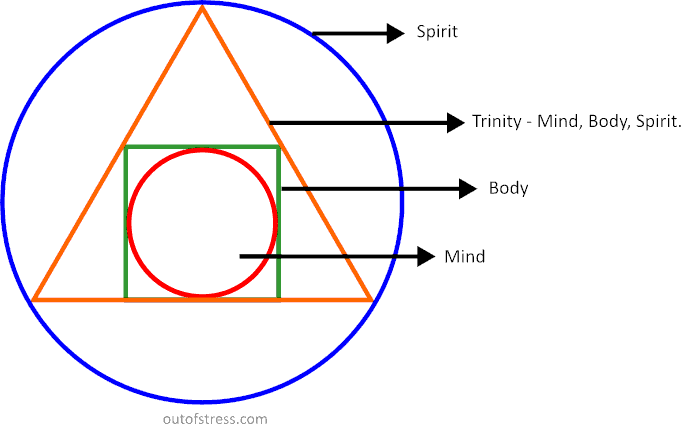
As you now know from this symbol’s other meanings, it conveys the divine masculine opposed with the divine feminine, and the spiritual realm opposed with the material realm. The philosopher’s stone symbol is therefore all about opposites, and how to reconcile them to achieve balance and union. You should keep this in mind on your journey of self-transformation.
One of the main facets of spiritual alchemy and shadow work is forging a well-balanced, unified self. Practitioners work on balancing their inner masculine and feminine, finding a balance between their inner light and their inner darkness, and refraining from taking any facet of their egoic self to the extreme.
So, if you’re on the journey of self-work, spiritual alchemy, and growth, make sure to refer to the philosopher’s stone symbol as your reminder to strive for balance in all aspects of your inner and outer life. Doing so will set you on the path toward divine inner harmony and—ultimately—spiritual enlightenment.
7. Spiritual Enlightenment
Conceiving the philosopher’s stone was often the end goal for alchemists who thought it would bring eternal life. In a similar vein, the philosopher’s stone symbol conveys the end goal for many spiritual alchemists—that is, spiritual enlightenment.
Historically, some practitioners would strive for an immortality-elixir and spiritual enlightenment at the same time. Such an alchemist would follow the following steps:
- 1. Calcinate base metals: This is done alongside abandoning your egoic self.
- 2. Dissolve the ashes: Alongside this, you surrender to the spiritual process.
- 3. Separate the pure elements: Now you identify your unconscious self.
- 4. Combine the elements: Now you start reconciling your inner conflicts and dualities.
- 5. Ferment the materials: Here you work on transforming yourself and growing 6. Philosopher’s stone is created: Finally, you reach spiritual enlightenment.
Yet not all alchemists worked with metals; many would carry out the spiritual side of the process only, and so can you! As a tribute to ancient alchemy, some of today’s practitioners enact rituals with candles and symbols like the philosopher’s stone, as a celebration of milestones on their journey to spiritual enlightenment.
You can use your conscious mind to bring unity between the mind, body, and spirit resulting in inner transformation.
Conclusion
From the universe and creation to inner transformation and enlightenment, the philosopher’s stone symbol has various, very significant spiritual meanings. It says a great deal that the philosopher’s stone has inspired spiritual alchemists for many centuries.
Follow in the footsteps of history’s alchemists and use the philosopher’s stone symbol to guide you in transmuting your inner self, achieving inner harmony and wholeness, and aligning with your highest self and universal consciousness.
If you’re curious for more, you can discover symbols related to the philosopher’s stone in our articles on spiritual triangles and wisdom symbols.


